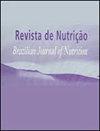肥胖的人体测量指标作为老年人全身性动脉高血压的预测因素:一项横断面分析
IF 0.5
4区 医学
Q4 NUTRITION & DIETETICS
Revista De Nutricao-brazilian Journal of Nutrition
Pub Date : 2023-01-01
DOI:10.1590/1678-9865202336e220137
引用次数: 0
摘要
摘要目的:分析不同性别老年人肥胖人体测量指标与高血压的相关性;比较高血压患者和非高血压患者在这些变量上的得分;并从中识别出那些对筛查结果有更好预测能力的人。方法:对210名老年人进行流行病学、基于人群的横断面研究。分析的人体测量指标为:体重指数、腰围、腹围、体脂指数、肱三头肌皮褶、腰臀比、腰高比、锥度指数。高血压诊断采用自我报告。结果:肥胖指标增加了高血压的发生概率。此外,老年高血压患者在肥胖指标上的得分高于非高血压患者(p <0.05)。对于男性,最敏感的指标是圆锥度指数(81.82%;截止点:1.30),最具体的是体重指数(69.77%;截止点:25.05 kg/m2)。对于女性来说,最敏感的指标是身体肥胖指数(86.08%;分界点:31.03%),最特异的是腹围(82.82%;截止点:98.70厘米)。结论:在两性中,肥胖指标与高血压呈正相关;高血压患者的各项指标得分较高。此外,身体肥胖指数(女性)和锥度指数(男性)显示出更强的高血压筛查能力,而腹部围和体重指数分别显示出更强的非高血压女性和男性的筛查能力。本文章由计算机程序翻译,如有差异,请以英文原文为准。
Anthropometric indicators of adiposity as predictors of systemic arterial hypertension in older people: a cross-sectional analysis
ABSTRACT Objective: To analyze the association of anthropometric indicators of adiposity in older people, according to sex, with hypertension; to compare the scores of these variables between participants with and without hypertension; and to identify among them those with better predictive ability for screening the outcome. Methods: Epidemiological, population-based, cross-sectional study conducted with 210 older people. The anthropometric indicators analyzed were: body mass index, waist circumference, abdominal circumference, body adiposity index, triceps skinfold, waist-to-hip ratio, waist-to-height ratio, and conicity index. Hypertension diagnosis was self-reported. Results: The indicators of adiposity increased the probability of hypertension. Additionally, hypertensive older people of both sexes showed higher scores on adiposity indicators than non-hypertensive subjects (p < 0.05). For men, the most sensitive indicator for the outcome was conicity index (81.82%; cut-off point: 1.30) and the most specific was body mass index (69.77%; cut-off point: 25.05 kg/m2). For women, the most sensitive indicator for the outcome was the body adiposity index (86.08%; cut-off point: 31.03%), and the most specific was the abdominal circumference (82.82%; cut-off point: 98.70 cm). Conclusion: In both sexes, the indicators of adiposity were positively associated with hypertension; hypertensive participants showed higher values in the scores of the indicators. Additionally, the body adiposity index (women) and conicity index (men) demonstrated greater ability to screen for hypertension, while the abdominal circumference and body mass index demonstrated greater ability to screen for non-hypertensive women and men, respectively.
求助全文
通过发布文献求助,成功后即可免费获取论文全文。
去求助
来源期刊
CiteScore
1.20
自引率
12.50%
发文量
24
审稿时长
6-12 weeks
期刊介绍:
Revista de Nutrição is former Revista de Nutrição da Puccamp, founded in 1988. It is a bimonthly publication every four months and it is of responsibility of the Centro de Ciências da Vida, da Pontifícia Universidade Católica de Campinas . It publishes articles that contribute to the study of Nutrition in its many sub-areas and interfaces; and is open to contributions of the national and international scientific communities.

 求助内容:
求助内容: 应助结果提醒方式:
应助结果提醒方式:


